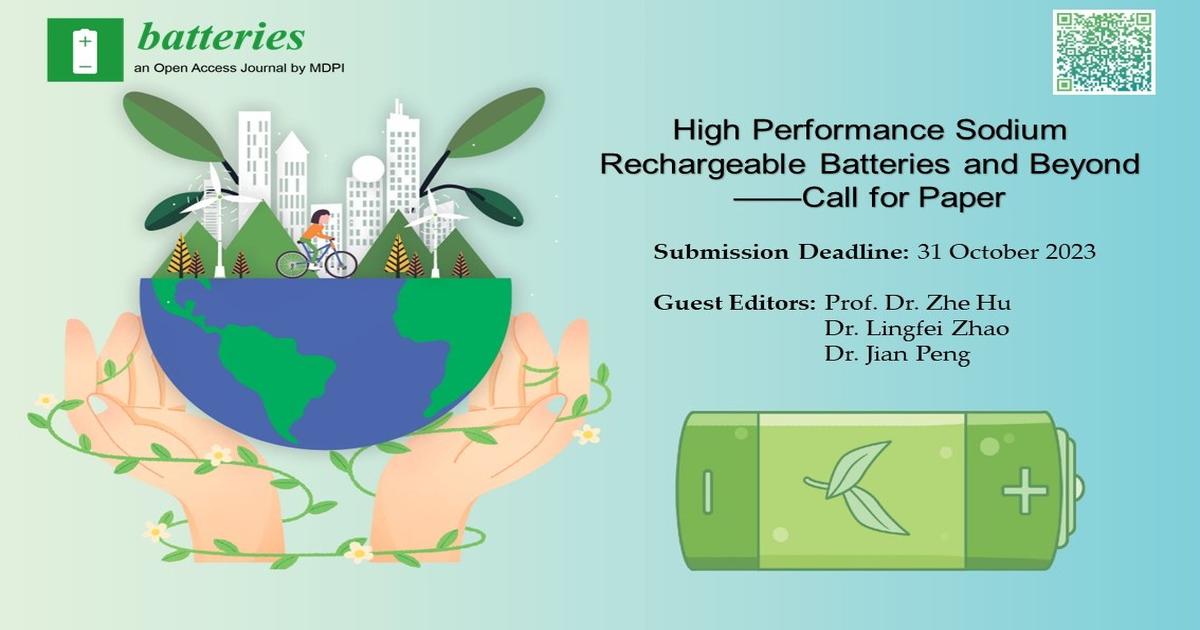High Performance Sodium Rechargeable Batteries and Beyond
A special issue of Batteries (ISSN 2313-0105). This special issue belongs to the section "Battery Materials and Interfaces: Anode, Cathode, Separators and Electrolytes or Others".
Deadline for manuscript submissions: closed (15 August 2024) | Viewed by 7129

Special Issue Editors
Interests: Li/Na/Zn ion batteries; Li/Na-CO2 batteries
Special Issues, Collections and Topics in MDPI journals
Interests: Li metal batteries; Na metal batteries; Na-ion batteries; Na/S batteries
Special Issues, Collections and Topics in MDPI journals
Interests: rechargeable batteries; electrode materials; metal–organic frameworks; energy storage devices; operando characterizations
Special Issues, Collections and Topics in MDPI journals
Special Issue Information
Dear Colleagues,
Sodium batteries (including sodium-ion, sodium-sulfur, and sodium-air batteries) are considered feasible alternatives to commercial Li-ion batteries, and hold great potential for grid-scale energy storage with low prices and high performance. Great achievements have been made for the early commercialization of sodium rechargeable batteries, while challenges including low initial Coulombic efficiency, insufficient cycling stability, and unsatisfactory all-climate performance remain. Rational material design and in-depth understanding of the mechanisms of sodium rechargeable batteries and beyond are, therefore, very meaningful and highly desirable.
In this Special Issue, we are looking for contributions including but not limited to:
- Novel electrode material design with new understanding and high performance;
- Rational electrolyte design via solvation structure engineering;
- Artificial solid-electrode interphase engineering;
- Quasi-solid and solid-state batteries;
- Practical approaches for high performance full cells;
- Multiscale mechanism understanding of the batteries;
- Advanced characterizations for the batteries;
- Other batteries beyond with exciting new findings.
As guest editors of this Special Issue, we are writing to encourage you to contribute your recent piece of work that is related; rapid communications, research articles, reviews, and perspectives are all welcome. We anticipate with pleasure receiving your submission of your latest research work on rechargeable sodium batteries and beyond.
Prof. Dr. Zhe Hu
Dr. Lingfei Zhao
Dr. Jian Peng
Guest Editors
Manuscript Submission Information
Manuscripts should be submitted online at www.mdpi.com by registering and logging in to this website. Once you are registered, click here to go to the submission form. Manuscripts can be submitted until the deadline. All submissions that pass pre-check are peer-reviewed. Accepted papers will be published continuously in the journal (as soon as accepted) and will be listed together on the special issue website. Research articles, review articles as well as short communications are invited. For planned papers, a title and short abstract (about 100 words) can be sent to the Editorial Office for announcement on this website.
Submitted manuscripts should not have been published previously, nor be under consideration for publication elsewhere (except conference proceedings papers). All manuscripts are thoroughly refereed through a single-blind peer-review process. A guide for authors and other relevant information for submission of manuscripts is available on the Instructions for Authors page. Batteries is an international peer-reviewed open access monthly journal published by MDPI.
Please visit the Instructions for Authors page before submitting a manuscript. The Article Processing Charge (APC) for publication in this open access journal is 2700 CHF (Swiss Francs). Submitted papers should be well formatted and use good English. Authors may use MDPI's English editing service prior to publication or during author revisions.
Keywords
- sodium-ion battery
- cathode
- prussian Blue Analog
- oxide
- polyanion
- sodium-sulfur battery
- sulfur cathode
- anode
- hard carbon
- metal anode
- electrolyte
- solvation structure
- solid-state
- Zn-ion battery
- interface
- mechanism
Benefits of Publishing in a Special Issue
- Ease of navigation: Grouping papers by topic helps scholars navigate broad scope journals more efficiently.
- Greater discoverability: Special Issues support the reach and impact of scientific research. Articles in Special Issues are more discoverable and cited more frequently.
- Expansion of research network: Special Issues facilitate connections among authors, fostering scientific collaborations.
- External promotion: Articles in Special Issues are often promoted through the journal's social media, increasing their visibility.
- e-Book format: Special Issues with more than 10 articles can be published as dedicated e-books, ensuring wide and rapid dissemination.
Further information on MDPI's Special Issue polices can be found here.







